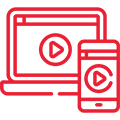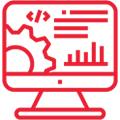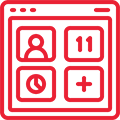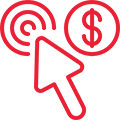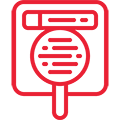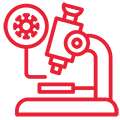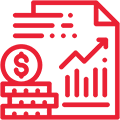“NEWMEDIA did everything; they created, launched, and hosted a completely new website using WooCommerce. Their willingness to get to know the client, the client’s needs, and their customer’s needs were very impressive to me.”
Top-Rated CRO Agency
Top-Rated CRO Agency Built to Maximize Conversions
As a data-focused conversion rate optimization agency, we help businesses achieve more from their existing traffic. Every strategy is designed to identify friction points, improve user experience, and increase the percentage of visitors who take action.
Our team combines analytics, UX design, and testing to uncover what truly drives engagement. By refining layouts, calls to action, and overall flow, we turn your website into a consistent revenue generator that delivers measurable, long-term results.
Our CRO Process
Research and Analysis
We start by analyzing user behavior, traffic sources, and conversion paths to identify where visitors drop off. Using tools like heatmaps, session recordings, and analytics data, we uncover usability issues and opportunities for improvement. Each finding shapes a focused CRO strategy built around your business goals.
Custom Strategy Development
Our team creates targeted hypotheses for testing based on real data, not assumptions. We develop action plans that prioritize key pages, user journeys, and design changes most likely to boost conversions. Every strategy is tested and refined to ensure measurable performance improvement.
A/B Testing and Optimization
We conduct controlled A/B and multivariate tests to evaluate new ideas, designs, and messaging. Every test delivers insights that help optimize site elements for better engagement and higher conversion rates. The process ensures steady improvement rather than short-term fixes.
Reporting and Continuous Improvement
Our reports go beyond numbers to explain what drives results. You’ll see clear metrics on conversion growth, user behavior, and ROI impact. We continue monitoring and refining strategies to keep performance strong as audience behavior and market trends evolve.
Case Studies
What’s Included in Our Conversion Rate Optimization Services
CRO Audits and Performance Analysis
We begin with a detailed CRO audit to evaluate your website’s current performance, user behavior, and conversion bottlenecks. Our analysis highlights where visitors drop off, which elements underperform, and what adjustments can immediately improve conversion rates and user engagement.
A/B and Multivariate Testing
We design and run A/B and multivariate tests to validate design, copy, and structural changes. Each test reveals how users respond to adjustments, helping us identify what drives higher engagement and sales with precision and confidence.
Optimization and Strategy Evolution
CRO is an ongoing process. We track performance continuously, evaluate results, and make data-driven refinements that sustain long-term growth. As audience behavior and market conditions shift, we adapt strategies to keep your conversion performance strong.
UX and Funnel Optimization
Our team refines every stage of the customer journey, from first click to final action. We improve navigation, layout, and content flow to reduce friction and guide users naturally toward conversion. Each enhancement is backed by usability data and real user insights.
Content and Design Refinement
We optimize landing pages, product descriptions, headlines, and calls to action for clarity and impact. Every visual and textual element is aligned with user intent to build trust, maintain attention, and encourage action without adding unnecessary complexity.
Comprehensive Reporting and Insights
You’ll receive clear reports that break down key metrics, test results, and performance improvements. Our insights highlight what works best and where further gains can be achieved, ensuring every decision is guided by measurable outcomes.
See Our Portfolio
Molly Hall Dorais
Colorado Rocky Mountain School
Request a CRO proposal with a clear plan, full pricing, and strategies to boost conversions.
Request a ProposalWhy Businesses Choose Our Conversion Rate Optimization Agency
Brands choose our conversion rate optimization agency to improve user experience, boost conversions, and maximize ROI without managing complex testing and analytics themselves. We handle every part of CRO, from audits and A/B testing to UX refinement and tracking, ensuring each change supports your business goals.
Clients continue working with us because our CRO strategies deliver measurable growth, higher engagement, stronger conversion rates, and increased revenue. With our experts overseeing the process, you can focus on scaling your business while we turn more visitors into paying customers.
What Customers Say About Us
Randall T.
Connect with our CRO experts today to get a personalized optimization plan and proposal.
Book a free consultationRelated Services
Your search for a reliable CRO agency ends here. Boost your conversions and ROI with our experts.
Get a free proposal

